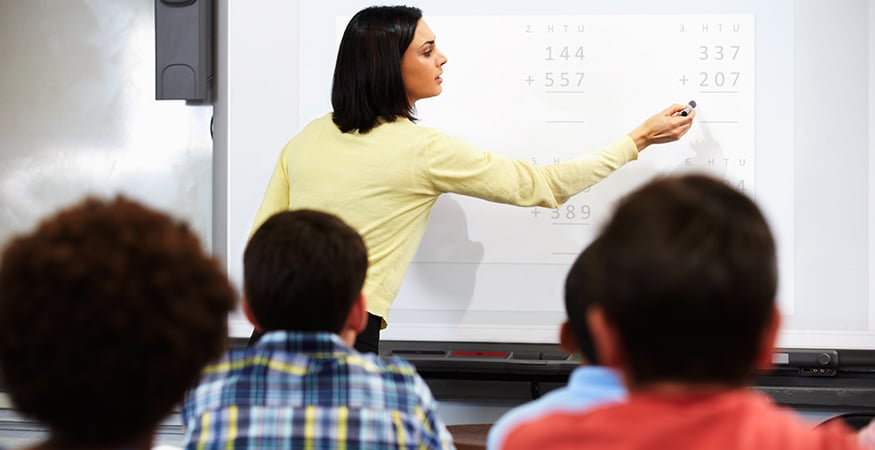Smart boards (interactive whiteboards) are an important educational tool that helped many teachers keep remote students engaged through active learning during the pandemic. Now, they continue to be an important technology to serve in-person, hybrid and remote classrooms. They even help sales teams connect with customers all over the world and make presentations of all kinds more powerful.
As students returned to classrooms, the need for smart boards didn’t go away. In fact, this type of smart technology might be more essential than ever. How does a smart board work and what are the benefits?
Article at a glance:
What Is a Smart Board?
Smart boards — sometimes called interactive whiteboards or electronic whiteboards — are large display devices that are often wall mounted or attached to mobile carts. The devices allow users to interact, collaborate and manipulate data by touching the board or with a simple mouse click.
A smart board is an interactive tool for teachers and students that allows users to edit and annotate directly on the screen with a stylus or their finger. Users also have the capability to communicate, edit and interact with devices such as smartphones, tablets, Chromebooks, and computer screens.
Smart Board Benefits for Educators and Students
Imagine capturing all the content on a traditional blackboard, dry-erase board or paper flip chart and digitizing it so it can be sent to the entire classroom or other teachers. Or, what if students — whether remote or in the classroom — could answer questions, draw their ideas or write out calculations that their classmates and teacher can see? Then, the information can be instantly saved and stored.
Smart boards help students with different learning styles. Visual learners love the sharp display and interactive functions, and auditory learners can listen to multimedia content. Those who are more hands-on can write with their finger or a stylus, and the functionality allows teachers to address an entire group or focus on one-on-one learning.
Interactive tools help students learn and keep them engaged. These are just a few of the major benefits of smart board technology for educational environments. Many of these benefits also translate to the corporate world.
How Does a Smart Board Work?
Like old-fashioned, dry-erase whiteboards, smart boards are used to share messages, capture information and facilitate brainstorming and team collaboration. They have the same basic conventional features, but leverage PC technology and connect to the internet to dramatically increase the range of functions.
Their large digital flat displays make the devices easy to use and interact with, using capacitive touch with up to 20 points of contact. Handwriting and character recognition are generally included, along with a stylus, digital pen, and sometimes keyboards depending upon the user environment. They can use multi-media like PowerPoint presentations and different software apps to give end users specialized learning tools to engage students or colleagues.
For video conferencing, the newest devices integrate with Microsoft Teams, Zoom, Skype and Google apps. Remote students or workers can now collaborate and meet from anywhere. Onboard speakers are generally included, but the smart boards can also be equipped with optional audio output to enhance user experiences. You can even tie multiple units together to form a cohesive video messaging system or video wall — the ultimate digital projector.
The displays may include an optional full functioning PC controller. In addition, smart boards use many different types of inputs including USB, HDMI, DisplayPort Input, VGA, DVI-D, or direct connection to any network resource along with wireless functionality.
Considerations When Buying a Smart Board
Smart Board Size and Resolution
Choose the correct size for your room or application; the optimum viewing size and angle are important to reduce neck and eye strain. The most popular sizes range from 32 inches to 86 inches, but the environment determines which size is best. A classroom may require a board from 75 to 86 inches, while a smaller meeting room may only need a 55-inch board.
Smart Board Software
Software apps are an important aspect. If PC based, Windows and the Microsoft Suite are very versatile and extremely functional. Cloud services, educational or other industry-specific software that enhance functionality, connectivity, storage or performance are important items to consider. Be sure to research the software you need for your equipment, as software is crucial for providing superior functionality.
Smart Board Costs
The larger the smart board unit, the higher the acquisition cost. Consider the room and audience for your display before deciding. Resolution of 4k or better works well for nearly all education and business collaboration needs. A 55-inch board can be had for under $1,000, while a 98-inch board can cost more than $10,000.
RELATED: 4 Compelling Benefits of Leasing Equipment vs. Buying
Make sure you know what software you will need for your interactive whiteboard, as it can equal or even exceed the price of the actual display board. Specialized applications and programs can cost from $0 to over $600 per instance depending on the app. Cloud services or other software that enhances connectivity, storage or performance can cost between $150 and $1,500 per month.
Accessories and other extras for your smart board also add to the cost of your interactive display solution. Pens, pen trays and erasers can range from $25 to over $200. Wall mounts and rolling stands can range from $250 to well over $1,500. Extra cameras or camera upgrades can cost from $100 to $250 depending on resolution and features.
What is the Best Smart Board?
Ask your Gordon Flesch Company (GFC) Account Executive about the models offered and which are the best solution for your needs and investment (GFC offers Ricoh Interactive White Boards because we believe them to be reliable and perform exceptionally well for the investment). Also consider leasing vs. buying as this technology will change over a 60-month period. GFC Leasing offers an array of flexible financing options to help you keep your technology up to the latest standards.
Our experienced team will help you find the correct device for your needs that will last for many years. GFC helps guide clients from research and acquisition through installation and configuration.
If you’d like to learn more about the latest in interactive whiteboard technology, talk to the technology experts at Gordon Flesch Company. We have a range of interactive smart board options and technology analysts who will make sure your new whiteboards easily integrate and enhance your existing presentation technology.










